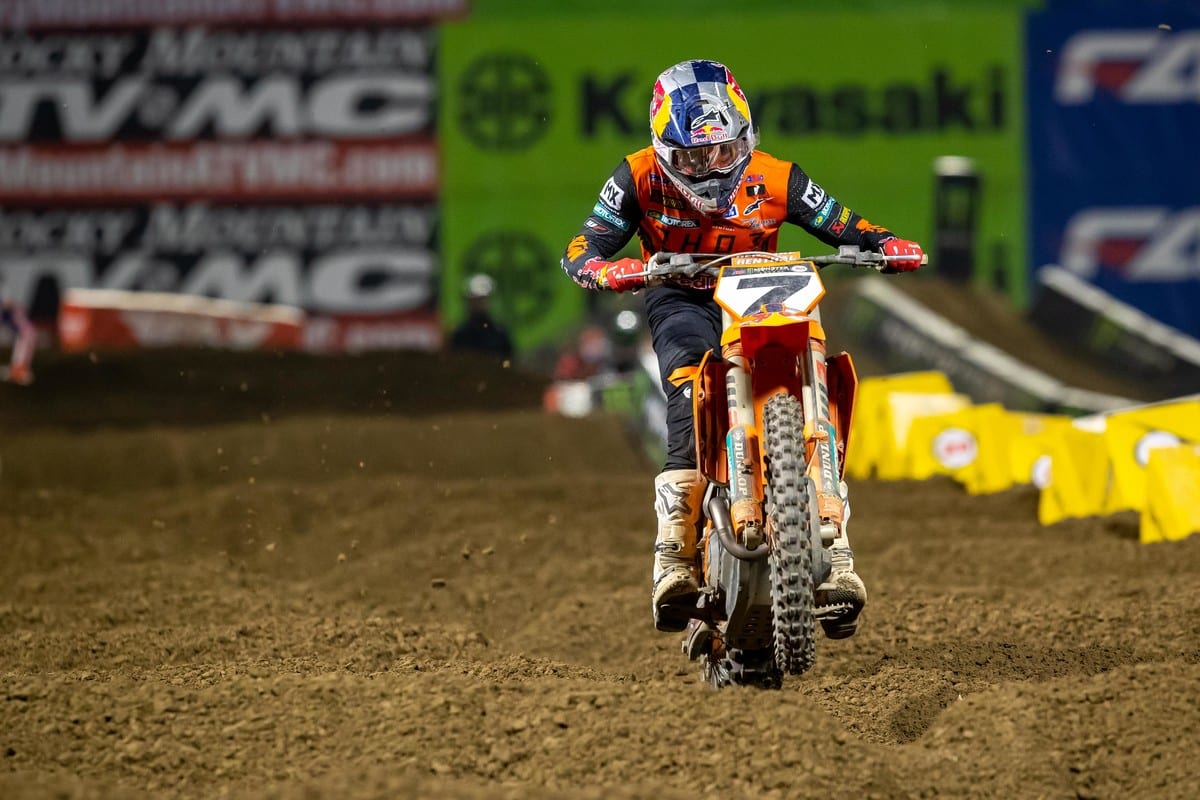
Supercross: Why Plessinger is like Petrucci, Cianciarulo is and isn’t a hero, and Craig is like a Ducati
I had planned to write one of these last week, after Anaheim 1. But I decided that I did not have anything interesting to say. That is still true, but perhaps I can write it in an interesting way. We’ll see.
Ken Roczen flew to Oakland for the second round of the 2022 AMA Supercross Championship – that’s AMA Supercross, AMA Supercross, no longer an FIM World Championship, as I’m certain almost everybody already knows, but for the benefit of those who don’t – with the championship leader’s red plate after denying Justin Barcia a fourth-straight season opening victory at Angel Stadium on 8 January.
The Oakland race did not start so well for the #94, though, crashing in one of the whoops sections – the longer of the two, that came before a 90-left – in second qualifying. Chase Sexton went down with Roczen, making contact with his Honda HRC teammate. Both were okay and made the night show relatively unhindered, but after the overwhelming positivity for the two Riding (factory) Red in Anaheim, Oakland would hit a different note.
Sexton won his heat, the first for the 450SX riders, while Roczen ended his in second place, three seconds adrift of Eli Tomac who saw his first chequered flag as a Star Racing Yamaha rider in Heat 2.
Tomac had been one of the strongest riders in the afternoon, setting three sub-one-minute lap times in second qualifying – a tally no one else could match. Marvin Musquin, Malcolm Stewart, Dylan Ferrandis and Cooper Webb were all able to set two laps in the 59-second bracket, though, and with other riders also sprinkling in sub-60 laps, there were plenty of riders who stood a chance come Main Event time.
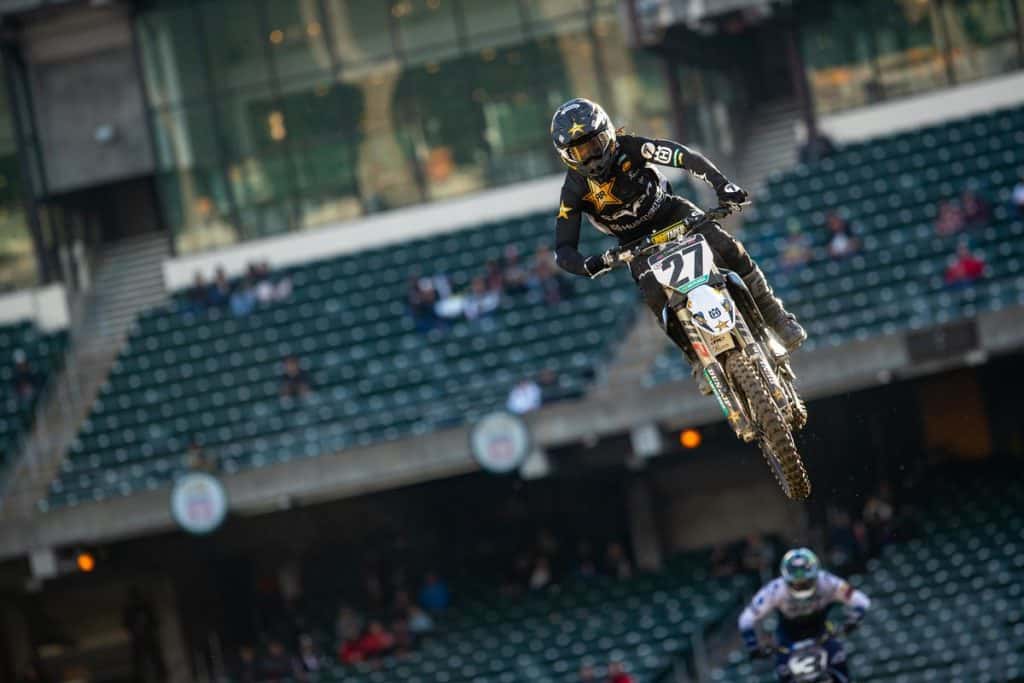
It is not unusual for a number of riders to enter a Main Event with a chance of winning in Supercross. The deltas are often so minimal, and – this applies especially to this year – there are always so many promising riders, either coming up from 250s, or having moved teams, that it can be hard for one rider to distinguish themselves from the rest. Usually, the separation does not come until the second half of the 20-minute Main, when the track is broken down and those who are talented enough, and comfortable enough with their machinery to adapt, come to the fore as the surface becomes increasingly rough, unpredictable, and complicated.
Cooper Webb and Eli Tomac have become the class of the field late in motos in recent years, Webb with his ability to turn low in a corner and avoid the ruts further up the berm, and Tomac with his raw aggression to hustle and force the bike through the roughness. But Webb is two races into his first season with a new-model KTM 450 SX-F, designed to be longer than its predecessor to aid stability in the whoops, possibly at the expense of turning agility; and Tomac is the same length of time into his Star Racing Yamaha career after five years on Kawasaki.
After Anaheim, the lesson was that ‘the more things change, the more they stay the same’, to which Steve Matthes eluded across his array of podcasts in the week since the season opener, including his PulpMX Show. Oakland, though, was – mostly – different.
Adam Cianciarulo made the holeshot. In the heat race he was already beginning to struggle with strength in his injured left shoulder, a grade three AC separation – you know. His losses in the two whoops sections were, as in Anaheim, visible, which, basically, is a synonym for ‘colossal’ in a racing context – you know. Cianciarulo’s A1 ride was valiant, running top three for the first half before dropping back later on when those behind stopped massacring each other and realised there was a podium up for grabs. Oakland appeared less heroic, but, realistically, what does that actually mean? Not that racers can’t be heroes, but what qualifies as objectively heroic? And who gets to make that determination? Whatever the case, it’s probably not me, and probably not you. But that’s why we choose our own heroes, because it isn’t objective.
Anyway, Cianciarulo’s gig was clearly up when he was passed by Eli Tomac in the 90-right after the rhythm before the first crossing of the start straight on lap 10. The Kawasaki #9 looked over his shoulder, and when he was later passed by Cooper Webb in the last turn before the finish, and subsequently followed through on by Dylan Ferrandis, he shook his head, which seemed like an admission of the severity of his struggles. Cianciarulo was content with 11th in Anaheim, but plunging through the pack at lightspeed twice in the space of a week cannot be great for the short term mood of a rider used to finishing on the podium, however aware they are of their current physical limitations. In any case, Cianciarulo will be back to the front when his injury has recovered, but that moment is, objectively, not now.
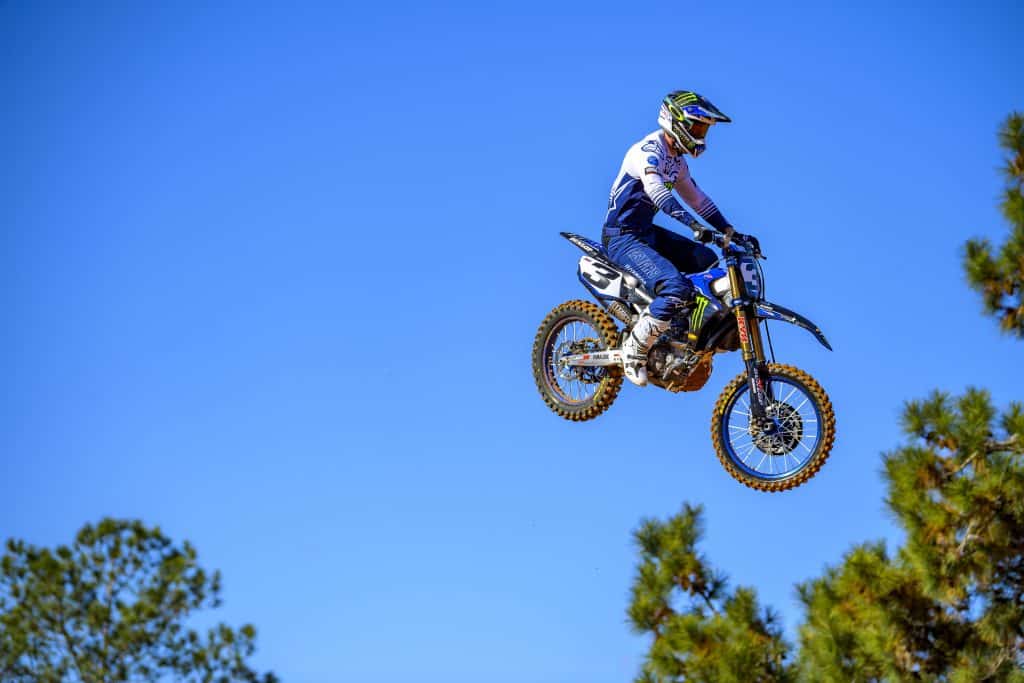
When Tomac passed Cianciarulo he was seven seconds behind, with around 10 minutes to go. With Justin Barcia, Aaron Plessinger and Jason Anderson ahead, the opportunity seemed to be there for Tomac to chase his first win in blue, especially considering his qualifying speed, and his history of being strong on beaten up tracks. However, Tomac instead dropped back, and finished the race almost 10 seconds behind the winner, the aforementioned Anderson, who replaced Tomac at Kawasaki for 2022.
Before Oakland, Anderson had not won since Atlanta 2018, the year he won the championship, and, having spent most of 2019 injured, and the two seasons since attempting to return to the front without much success, he arrived at Kawasaki with a point to prove and a question to answer, namely ‘could Jason Anderson win another Supercross?’
In Anaheim, Anderson had podium pace but, as Jason Thomas put it on his Industry Seating podcast reviewing the ‘22 opener, he “poked the ‘Barcia Bear’”. The result was a crash, a 10th-place finish and a rumoured hand injury. Not the ideal start to his KRT career, but he showed the speed was there.
Having made a strong start in Oakland, he as able to pass his ailing teammate, Cianciarulo, for the lead after three laps and, although Aaron Plessinger was also able to clear the second factory Kawasaki relatively quickly, Anderson was able to eventually make his escape at the front. The #21 opened up over four seconds by the time the race clock hit zero, leaving Anderson to a relatively calm final lap to take what was an overdue win.
Presumably, over the next week many people will ask “can Jason Anderson win a second 450SX championship?” The honest answer is that we’re two rounds in so no one knows. Blake Baggett won round two in 2019.
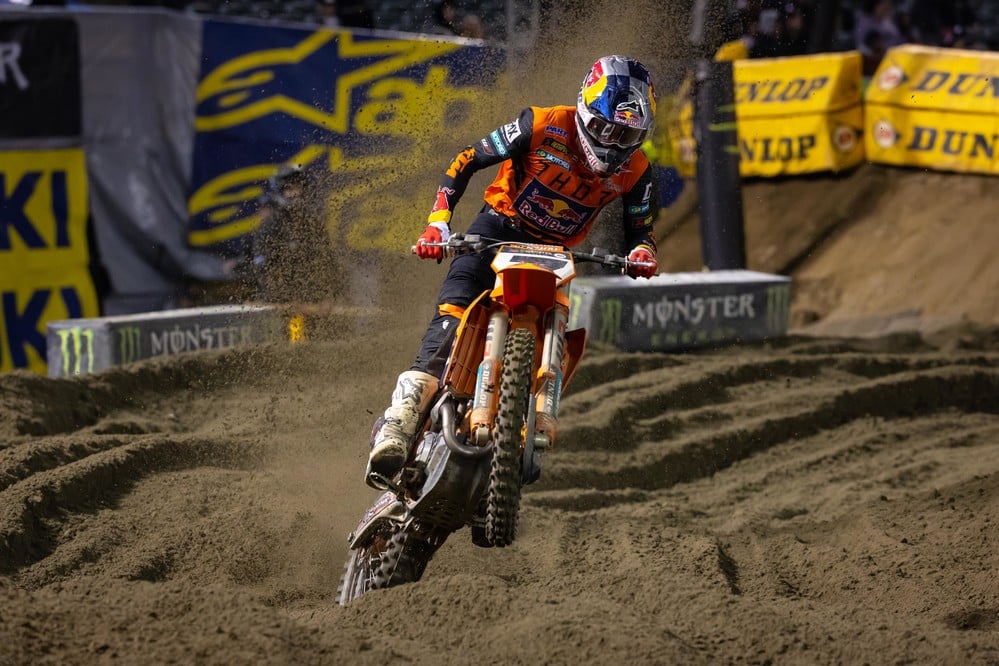
Aaron Plessinger’s Anaheim was quite miserable. I like Plessinger, because he’s about as interesting as it gets in racing, as proven by his podium interview, which if you missed you should try to find. As a Brit, Plessinger about as far outside my known reality as it gets for a guy whose first language is also English. But the big hat (reluctant to name it something and be wrong), the mullet, the facial hair- it’s just cool. It’s really, really, cool, and it’s cool that Plessinger leans into it, because it feels like he’s genuine.
I don’t think people realised how much they liked Danilo Petrucci until this year’s Dakar. And it wasn’t his winning stage five that woke people up to that, but his tears in the moments after he found out he won, and the self-shot video he posted on his social media of him pulling over during a road section of the rally to let some excited kids rev his bike. When Petrucci was in MotoGP, people inside the paddock would often talk of how much of a nice guy he was, or is, and, although we saw him emotionally explode after his win in Mugello, I think it took Petrucci to find his own space – not that the Dakar is his, but in the context of the 2022 edition, when many MotoGP fans were paying attention not necessarily to the Dakar but to Danilo Petrucci’s Dakar – for the reality of his personality to be fully expressed. And I think the reason people like Petrucci is the same reason they like Plessinger: because he’s genuine. What stood out as Petrucci’s most appealing characteristic in MotoGP – his kindness – also stood out in the desert of Saudi Arabia. And, for Plessinger, it continues to stand out in orange as it did in blue that he likes to have fun, and that he likes to spread that fun and enjoyment to the people around him, which on race days extends to the fans – both in the stands and at home. Tough to watch an AP interview with a straight face.
I’m so used to writing race reports, and writing in a specific way with a specific routine that I feel obliged to now write something about how Cooper Webb was quite disappointing but it’s early so it doesn’t matter; Dylan Ferrandis still has not fixed his starts; Malcolm Stewart lacked flash but quietly impressed with fifth, and how Stewart just quietly being a fifth-place guy is actually kind of important; that Justin Barcia now has the red plate; and that I never got back to the factory Hondas. But apart from the words I have just written, I don’t have anything interesting to say about any of those people, so I’m going to write about 250s instead.
Is Christian Craig being in 250s fair? It was a question posed by a few people coming into Oakland after the California native dominated Anaheim last week. Perhaps they didn’t word it exactly like that, but the inference made was that because he is 30 it is unfair that he is racing guys in their teens. Firstly, it is worth noting that Craig himself answered the question of whether he should be in the 250 class on social media. Secondly, the answer to the original question is ‘no, it isn’t fair.’ Not because of his age, though.
I was trying to figure out how to merge “Christian Craig” with “Desmosedici”, but the best I could come up with was “Craigmosedici”, but that’s not very good. But the point is this: in MotoGP, the Ducati Desmosedici is so fast in a straight line that the pilots of the other manufacturers simply have to accept their undesirable fate. In 250SX West, Christian Craig is so fast in the whoops that the other riders simply have to accept their undesirable fate. In fact, in Oakland on Saturday night, Jo Shimoda was so afraid of what awaited when he entered the whoops, that he stalled his Kawasaki before he arrived at them. Craig duly passed, and disappeared. He won his second race in succession, going back-to-back for the first time in his, apparently, notoriously long 250SX career. Can he win the championship? Yes. Should he? Probably. Will he? Find out in May.
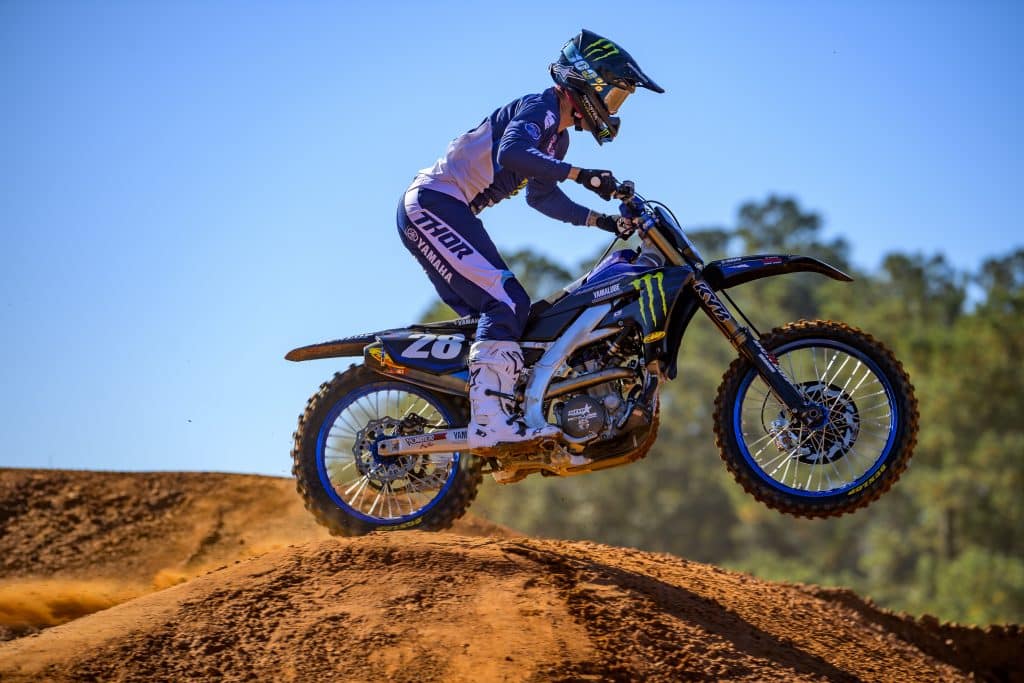
Certainly, a Christian Craig championship win is not in the plans of Seth Hammaker, Hunter Lawrence, Jo Shimoda or Michael Mosiman, but after two races Craig has been mostly unchallenged by any of them, for one reason or another, which I will now detail.
Hammaker lacks just a little bit of everything compared to Craig, nothing specific, and perhaps the ultimate difference between the two is simply confidence. Craig has a lot of experience, both in life and racing, which – I imagine – leads to substantial mental stability. Seth Hammaker, because he is young both in life and in racing, doesn’t have the experience of Craig in either, which leads to more uncertainty and less base confidence. It might take some races for Hammaker’s confidence to gather, but he has the speed and safety (not that he’s too reserved, but he’s also not exactly sketchy) for it to gather. Unfortunately for Hammaker, it’s a short series, Craig is two-for-two, and there are another two Anaheim rounds.
Hunter Lawrence has not started very well in the first two races, and has had too much work to do from early on to be able to go with Craig, who has started well, and ridden well between the holeshot line and the chequered flag in both Anaheim and Oakland. Lawrence’s subdued starts could be explained by his anticipation of racing the east coast, before his brother and teammate, Jett, crashed the week before A1. Perhaps some small lack of preparation ahead of the West season is hindering the #96 at the minute, but unfortunately for him the season is short, so he does not have much time to find his form and fix his starts before Craig is out of reach.
Jo Shimoda built his reputation in the last two seasons on consistency. However, he came into this season expecting to fight for the championship, so he is pushing his limit more on speed. That is leading to mistakes. Unfortunately for him, it is likely going to take time to balance out the speed with the consistency. He probably will, but doing it in time to catch Craig in 2022 will be difficult.
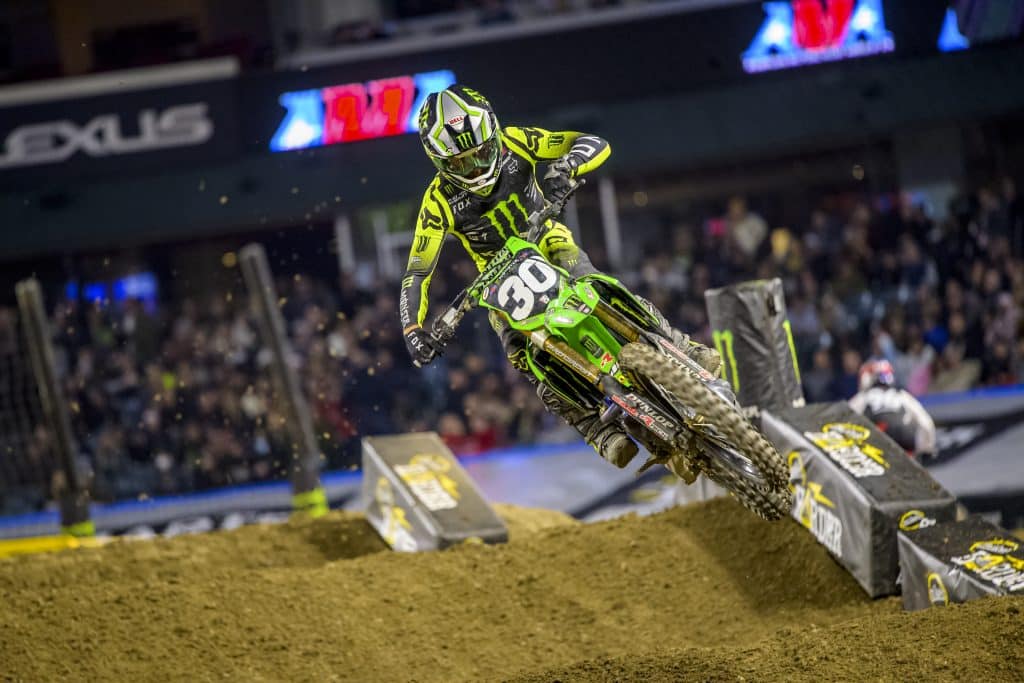
It is tough to know what to say about Michael Mosiman apart from that you could probably make an entire regional supercross series out of races he should have won. Mosiman is able to be fast without being too sketchy – a good combination – and yet he consistently finds himself on the floor, sometimes through his own fault, sometimes not. In 2021, Francesco Bagnaia won his first MotoGP race, and then pretty much couldn’t stop winning them before the season was out. For Mosiman, it feels like a similar ‘floodgates’ situation could occur, but, unfortunately for him, there is little time to get the first one out of the way and still have enough races left to close down Craig.
A final word on 250SX West to Mr. Garrett Marchbanks, who found himself – I would like to use the term “Froesen” in the Main Event in Oakland. Vince Friese saw a gap, that pretty much was of his own imagination, and then brought it into reality at the expense of the ClubMX Yamaha rider. Marchbanks did not really recover from the incident and finished eighth, but no doubt he will be looking for the #62 next Saturday night to ‘collect his debt’, a term which everyone who watched the Oakland Race Day Live show will be extremely familiar with by now. In the meantime, it might be suggested that Friese refer himself to Cameron McAdoo, who understands the capabilities of Marchbanks quite intimately, when the #35 wishes to introduce himself halfway up a berm.
Finally, it was the debut of the new Supercross Futures format. Ryder Difrancesco won. Convincingly. He had five seconds a lap on the field. It was not a great race, but Difrancesco looks a great rider, and that is pretty much the point of the series. So I suppose in that way it was a success.



![Private: [ID: 71rYi-xncgM] Youtube Automatic](https://motorradio-xijqc.projectbeta.co.uk/wp-content/uploads/2024/08/private-id-71ryi-xncgm-youtube-a-1-360x203.jpg)
![Private: [ID: 1SfHxvC8Doo] Youtube Automatic](https://motorradio-xijqc.projectbeta.co.uk/wp-content/uploads/2024/07/private-id-1sfhxvc8doo-youtube-a-1.jpg)
![Private: [ID: H6XRkf6kROQ] Youtube Automatic](https://motorradio-xijqc.projectbeta.co.uk/wp-content/uploads/2024/07/private-id-h6xrkf6kroq-youtube-a-1-360x203.jpg)
![Private: [ID: Kb6w-qAmKls] Youtube Automatic](https://motorradio-xijqc.projectbeta.co.uk/wp-content/uploads/2023/12/private-id-kb6w-qamkls-youtube-a-360x203.jpg)
![Private: [ID: CcpwYw20k3k] Youtube Automatic](https://motorradio-xijqc.projectbeta.co.uk/wp-content/uploads/2024/07/private-id-ccpwyw20k3k-youtube-a-360x203.jpg)

![[ID: x1SiRC5jhW4] Youtube Automatic](https://motorradio-xijqc.projectbeta.co.uk/wp-content/uploads/2022/04/id-x1sirc5jhw4-youtube-automatic-360x203.jpg)
![[ID: lMZ8lAeLubk] Youtube Automatic](https://motorradio-xijqc.projectbeta.co.uk/wp-content/uploads/2022/04/id-lmz8laelubk-youtube-automatic-360x203.jpg)
![[ID: GAYCcnqyFo4] Youtube Automatic](https://motorradio-xijqc.projectbeta.co.uk/wp-content/uploads/2022/04/id-gayccnqyfo4-youtube-automatic-360x203.jpg)
![[ID: Gg142H296QY] Youtube Automatic](https://motorradio-xijqc.projectbeta.co.uk/wp-content/uploads/2022/04/id-gg142h296qy-youtube-automatic-360x203.jpg)
![Private: [ID: 71rYi-xncgM] Youtube Automatic](https://motorradio-xijqc.projectbeta.co.uk/wp-content/uploads/2024/08/private-id-71ryi-xncgm-youtube-a-1-236x133.jpg)
![Private: [ID: H6XRkf6kROQ] Youtube Automatic](https://motorradio-xijqc.projectbeta.co.uk/wp-content/uploads/2024/07/private-id-h6xrkf6kroq-youtube-a-1-236x133.jpg)
![Private: [ID: Kb6w-qAmKls] Youtube Automatic](https://motorradio-xijqc.projectbeta.co.uk/wp-content/uploads/2023/12/private-id-kb6w-qamkls-youtube-a-236x133.jpg)
![Private: [ID: nc-8g6ROCe8] Youtube Automatic](https://motorradio-xijqc.projectbeta.co.uk/wp-content/uploads/2023/11/private-id-nc-8g6roce8-youtube-a-236x133.jpg)
![Private: [ID: wWrhfjOQuIc] Youtube Automatic](https://motorradio-xijqc.projectbeta.co.uk/wp-content/uploads/2023/11/private-id-wwrhfjoquic-youtube-a-236x133.jpg)